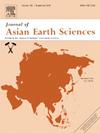The redox transformation in the Yangtze Sea across the Ordovician-Silurian transition: Evidence from zinc isotopes in organic-rich shales
IF 2.7
3区 地球科学
Q2 GEOSCIENCES, MULTIDISCIPLINARY
引用次数: 0
Abstract
Across the Ordovician-Silurian transition, the Yangtze Sea exhibited a complex redox pattern influenced by various environmental factors. Consequently, investigating this phenomenon is crucial for understanding the paleoenvironmental changes and their implications. Numerous and continuously evolving geochemical proxies provide insights into the redox conditions of paleo-oceans, among which the zinc isotope composition (δ66Zn) in organic rich shales has been recently discovered as a potential alternative proxy for local marine redox conditions. In this study, the core JY143, drilled in the middle Yangtze shelf, was selected as the research subject. The variation in δ66Zn values can be categorized into three distinct stages. The substantial influx of isotopically light Zn from igneous materials and its interaction with seawater may contribute to an overall lighter Zn isotope composition in seawater (δ66Znsw). Under conditions characterized by high paleoproductivity and elevated organic burial rates, biological absorption of light Zn is primarily responsible for the low δ66Zn values observed in organic-rich shales, indicating that organic-rich shales serve as an isotopically light Zn sink in the Yangtze Sea across the transition. Notably, the δ66Znsw values observed during stage 1 are significantly lower than those recorded in stages 2 and 3, as well as below lithogenic source, possibly because during the early diagenetic stage, an excess of isotopically light Zn relative to ZnS in pore water was remobilized and subsequently released into deep seawater under oxidizing conditions. In summary, the transformation from an oxic environment to an anoxic (and even euxinic) environment resulted in a marked increase in δ66Znsw values. This study presents new evidence from Zn isotopes regarding the oxic-anoxic (and even euxinic) transformation in the Yangtze Sea during the transition, while further underscoring the potential utility of δ66Zn in organic-rich shales as a redox proxy for local paleo-ocean environments.
求助全文
约1分钟内获得全文
求助全文
来源期刊

Journal of Asian Earth Sciences
地学-地球科学综合
CiteScore
5.90
自引率
10.00%
发文量
324
审稿时长
71 days
期刊介绍:
Journal of Asian Earth Sciences has an open access mirror journal Journal of Asian Earth Sciences: X, sharing the same aims and scope, editorial team, submission system and rigorous peer review.
The Journal of Asian Earth Sciences is an international interdisciplinary journal devoted to all aspects of research related to the solid Earth Sciences of Asia. The Journal publishes high quality, peer-reviewed scientific papers on the regional geology, tectonics, geochemistry and geophysics of Asia. It will be devoted primarily to research papers but short communications relating to new developments of broad interest, reviews and book reviews will also be included. Papers must have international appeal and should present work of more than local significance.
The scope includes deep processes of the Asian continent and its adjacent oceans; seismology and earthquakes; orogeny, magmatism, metamorphism and volcanism; growth, deformation and destruction of the Asian crust; crust-mantle interaction; evolution of life (early life, biostratigraphy, biogeography and mass-extinction); fluids, fluxes and reservoirs of mineral and energy resources; surface processes (weathering, erosion, transport and deposition of sediments) and resulting geomorphology; and the response of the Earth to global climate change as viewed within the Asian continent and surrounding oceans.
 求助内容:
求助内容: 应助结果提醒方式:
应助结果提醒方式:


